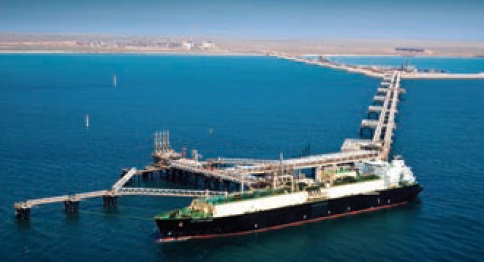Chevron's giant Australia LNG plant facing union calls for safety checks

Jetty at Chevron’s Gorgon LNG export plant. Photo courtesy of Chevron.
(Reuters) Forced to shut its $54 B Gorgon LNG export plant twice in its first five months, Chevron Corp. now faces calls from union officials for a probe into the site's safety.
Chevron denies there have been any safety breaches at the plant but is under pressure to resolve problems that have limited exports to just two cargoes since starting operations in March.
The Australian Manufacturing Workers' Union (AMWU) has told Reuters it has formally requested access to the site.
"The AMWU has concerns about safety at Gorgon," Steve McCartney, West Australian secretary of the AMWU, told Reuters via email.
A failed weld on a valve casing called a trunnion caused the gas leak that forced the plant to close on July 1, he said.
"The AMWU wants to know why it failed, and what checks were carried out to ensure it met Australian standards," McCartney said.
Chevron called the leak "minor", although it did evacuate some workers. On Wednesday the company said it expected to resume production shortly.
"Chevron Australia is in discussions with the AMWU to visit the site as part of usual union engagement with its members," a spokeswoman said, adding that there had been no safety breaches at the plant.
Reuters could not independently confirm whether the issues at the plant pose any risk to worker safety.
MISTAKES
Chevron, which is counting on Gorgon to help it become an LNG leader in Asia, reported its first shutdown in April and was forced to shut again following a gas leak on July 1.
In interviews with Reuters, site workers and industry sources familiar with operations at Gorgon said mistakes led to the first shutdown.
According to information provided by one engineer at the plant, liquid propane in the refrigerant circuit flooded into a section of pipeline meant to handle gases only.
Metal debris inside the piping was propelled along at speed, damaging equipment and producing "very loud clunking noises" which prompted operators to initiate emergency shutdown procedures, according to one worker and corroborated by AMWU's McCartney.
Chevron said the problem occurred in the propane refrigerant circuit where natural gas is cooled into a liquid but declined to provide further details.
LAGGING RIVALS
The shutdowns have cost Gorgon more than $200 M in lost output, excluding repairs and other expenditures, one industry consultant estimated, basing the figure on an export schedule of around one cargo per week.
The outages have also contributed to a jump in global LNG spot prices, which are up by around 40% since April.
Two industry sources said Chevron ignored advice from project partners Royal Dutch Shell and Exxon Mobil to go slow with the launch of Gorgon.
"Gorgon's teething issues mirror the ongoing problems at Angola LNG and put the spotlight on Chevron," said Rystad Energy analyst Readul Islam regarding Chevron's ability to deliver LNG plants.
Chevron and partners BP, ENI and Total has just finished work on its LNG plant in Angola following a two-year shutdown to fix design flaws.
Operations tentatively resumed at the plant just last month.
Meanwhile, rivals have moved forward, with Exxon Mobil launching its Papua New Guinea (PNG LNG) liquefaction plant on time and on budget in 2014, when Gorgon was first due to start operations.
"The relatively niggle-free ramp-up of Gladstone LNG (in Australia) as well as the PNG LNG trains over the past two years could lead to questions being asked of Gorgon's onshore (start-up) team," said Rystad's Islam, but he added that Gorgon's greater complexity and size arguably make it a bigger challenge.
Industry sources and analysts continue to project start-up delays at subsequent phases of Gorgon due partly to the latest hiatus.
Chevron denies this. It says that construction on Gorgon production lines two and three, which will boost its export capacity to 15.6 M tones a year in 2017, are unaffected.
Peter Coleman, chief executive of Woodside Petroleum which is partnered with Chevron in developing the $33 B Wheatstone LNG project in Australia, said his company was taking a more hands-on role in development as Chevron is "having to direct resources elsewhere".
But he added he had no concerns about Chevron as a project operator.
"They've got a lot on their plate and so many hands help, and that's where we are at the moment," he said.
Reporting by Sonali Paul, Oleg Vukmanovic, and Ron Bousso; Additional reporting by Sarah McFarlane and Ernest Scheyder; writing by Oleg Vukmanovic; editing by Jason Neely

- ExxonMobil halts 1-Bft3d blue hydrogen project in Texas
- Aramco and Yokogawa commission multiple autonomous control AI agents at Fadhili gas plant
- Ukraine will resume gas imports via Transbalkan route in November
- Mitsubishi to inject $260 MM into Brunei LNG project
- Freeport LNG (U.S.) on track to take in more natgas on Thursday after unit outage



Comments